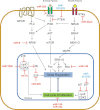MicroRNA and cutaneous melanoma: from discovery to prognosis and therapy
- PMID: 22693259
- PMCID: PMC3529555
- DOI: 10.1093/carcin/bgs205
MicroRNA and cutaneous melanoma: from discovery to prognosis and therapy
Abstract
Melanoma incidence and associated mortality continue to increase worldwide. The lack of treatments with durable responses for stage IV melanoma may be due, at least in part, to an incomplete understanding of the molecular mechanisms that regulate tumor initiation and/or progression to metastasis. Recent evidence supports miRNA dysregulation in melanoma impacting several well-known pathways such as the PI3K/AKT or RAS/MAPK pathways, but also underexplored cellular processes like protein glycosylation and immune modulation. There is also increasing evidence that miRNA can improve patient prognostic classification over the classical staging system and provide new therapeutic opportunities. The integration of this recently acquired knowledge with known molecular alterations in protein coding genes characteristic of these tumors (i.e., BRAF and NRAS mutations, CDKN2A inactivation) is critical for a complete understanding of melanoma pathogenesis. Here, we compile the evidence of the functional roles of miRNAs in melanomagenesis and progression, and of their clinical utility as biomarkers, prognostic tools and potential therapeutic targets. Characterization of miRNA alterations in melanoma may provide new angles for therapeutic intervention, help to decipher mechanisms of drug resistance, and improve patient classification for disease surveillance and clinical benefit.
Figures
Similar articles
-
The role of microRNAs and long non-coding RNAs in the pathology, diagnosis, and management of melanoma.Arch Biochem Biophys. 2014 Dec 1;563:60-70. doi: 10.1016/j.abb.2014.07.022. Epub 2014 Jul 24. Arch Biochem Biophys. 2014. PMID: 25065585 Free PMC article. Review.
-
MicroRNAs in cutaneous melanoma: Role as diagnostic and prognostic biomarkers.J Cell Physiol. 2018 Jul;233(7):5133-5141. doi: 10.1002/jcp.26395. Epub 2018 Jan 19. J Cell Physiol. 2018. PMID: 29226953 Review.
-
MicroRNA regulation of melanoma progression.Melanoma Res. 2012 Apr;22(2):101-13. doi: 10.1097/CMR.0b013e32834f6fbb. Melanoma Res. 2012. PMID: 22209751 Review.
-
miRNAs as Key Players in the Management of Cutaneous Melanoma.Cells. 2020 Feb 11;9(2):415. doi: 10.3390/cells9020415. Cells. 2020. PMID: 32054078 Free PMC article. Review.
-
NRAS mutant melanoma: Towards better therapies.Cancer Treat Rev. 2021 Sep;99:102238. doi: 10.1016/j.ctrv.2021.102238. Epub 2021 May 29. Cancer Treat Rev. 2021. PMID: 34098219 Review.
Cited by
-
High intensity focused ultrasound inhibits melanoma cell migration and metastasis through attenuating microRNA-21-mediated PTEN suppression.Oncotarget. 2016 Aug 2;7(31):50450-50460. doi: 10.18632/oncotarget.10433. Oncotarget. 2016. PMID: 27391071 Free PMC article.
-
A miRNA-Based Signature Detected in Primary Melanoma Tissue Predicts Development of Brain Metastasis.Clin Cancer Res. 2015 Nov 1;21(21):4903-12. doi: 10.1158/1078-0432.CCR-14-2566. Epub 2015 Jun 18. Clin Cancer Res. 2015. PMID: 26089374 Free PMC article.
-
Up-regulation of KISS1 as a novel target of Let-7i in melanoma serves as a potential suppressor of migration and proliferation in vitro.J Cell Mol Med. 2021 Jul;25(14):6864-6873. doi: 10.1111/jcmm.16695. Epub 2021 Jun 6. J Cell Mol Med. 2021. PMID: 34096173 Free PMC article.
-
Pivotal MicroRNAs in Melanoma: A Mini-Review.Mol Diagn Ther. 2016 Oct;20(5):449-55. doi: 10.1007/s40291-016-0219-y. Mol Diagn Ther. 2016. PMID: 27351922 Review.
-
miR-204-5p acts as a tumor suppressor by targeting matrix metalloproteinases-9 and B-cell lymphoma-2 in malignant melanoma.Onco Targets Ther. 2017 Feb 27;10:1237-1246. doi: 10.2147/OTT.S128819. eCollection 2017. Onco Targets Ther. 2017. PMID: 28280358 Free PMC article.
References
-
- Bleyer A., et al. (2006). Cancer in 15- to 29-year-olds by primary site. Oncologist 11 590–601 - PubMed
-
- Lee R.C., et al. (1993). The C. elegans heterochronic gene lin-4 encodes small RNAs with antisense complementarity to lin-14. Cell 75 843–854 - PubMed
-
- Reinhart B.J., et al. (2000). The 21-nucleotide let-7 RNA regulates developmental timing in Caenorhabditis elegans. Nature 403 901–906 - PubMed
-
- Bernstein E., et al. (2003). Dicer is essential for mouse development. Nat. Genet. 35 215–217 - PubMed
Publication types
MeSH terms
Substances
Grants and funding
LinkOut - more resources
Full Text Sources
Other Literature Sources
Medical
Research Materials
Miscellaneous




